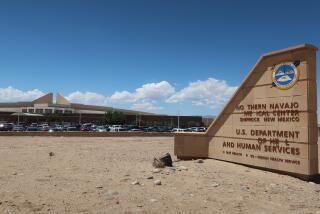IRVINE : Group Works to Help American Indians
- Share via
A deserted business park is the nerve center of a humanitarian effort that brings food, clothing, books and hope to a handful of poverty-stricken American Indian reservations in South Dakota and Montana.
The Red Cloud American Indian Society works mostly with the Sioux tribes to provide items for daily sustenance, as well as materials such as computers and school textbooks that help the reservation-based American Indians improve the quality of their lives.
“They need the computers as much as they need the food,” said Irvine resident Darlene Asroui, one of 50 volunteers at the society.
“The education is very important to them . . . and their future.”
The nonprofit organization is run by Phil Stevens, a retired engineering company executive who is part Sioux.
The headquarters on Von Karman Avenue is filled with an assortment of colorful American Indian feather headdresses, artwork and paintings.
The office is also littered with dozens of boxes, packed with everything from clothing donated by Liz Claiborne to used dictionaries and romance novels given by the Irvine Unified School District.
In just the past few months, the group has provided the tribes with more than 35,000 pounds of food, 25,000 pounds of clothing and 80,000 books.
The society awards scholarships to American Indian students and helped a tribe in Florida that was caught last year in the path of Hurricane Andrew.
“We try to help as much as we can,” said executive director Hugh Margesson, who estimated that Red Cloud’s work has touched some 250,000 lives.
The society receives funding from individual and corporate donations as well as from grants. But it’s usually not enough to meet the need.
Even though Margesson is the only paid employee, the group must turn away some donations, because it lacks funds to ship the items to the reservations.
The society also tries to avoid sending items that are worn or defective.
“We try not to send up white elephants and junk. They’ve gotten so much of that stuff for years,” Margesson said. “If it looks too second-class . . . the kids might feel that way.”
A top priority is collecting computers--both from companies and families that have upgraded their equipment.
By providing reservation schools with such high-technology items, Margesson and others hope the young people will gain the educational edge necessary to attend college and learn valuable skills.
But much of their effort these days is focused on the tribes’ everyday needs for food, clothing and other necessities.
Among the most popular items recently donated were 389 mattresses, which were accepted gratefully by reservation residents who are used to sleeping on the floor.
More to Read
Sign up for Essential California
The most important California stories and recommendations in your inbox every morning.
You may occasionally receive promotional content from the Los Angeles Times.














